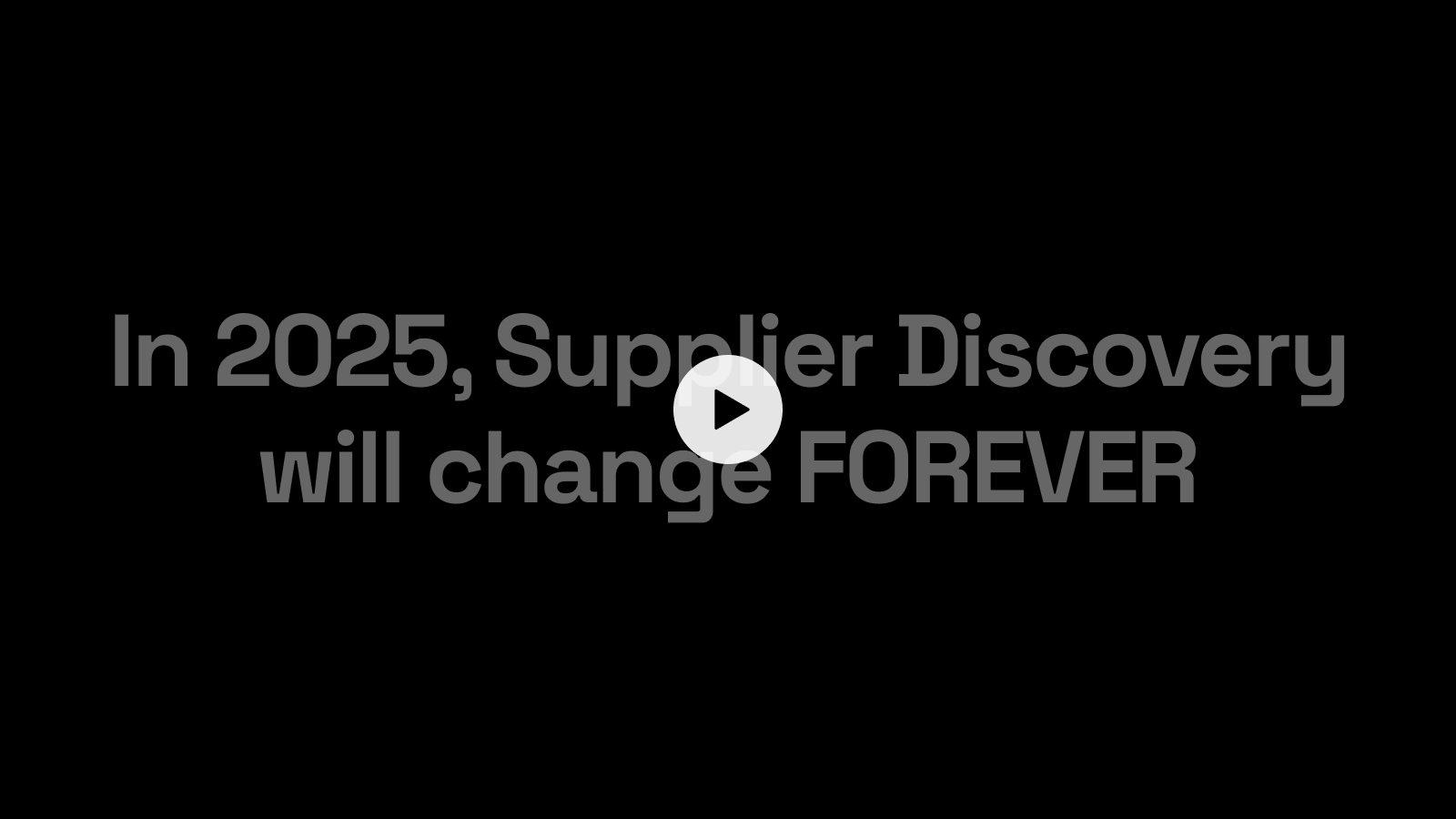A deep dive into Veridion’s Complex Search API


Find suppliers across any category or industry with advanced filtering, real-time search capabilities, and weekly data updates.










We love our data, and now that you're here, you're one step closer to loving it too.
A wide sample of data, so you can explore what is possible with our data
Choose ->
built with procurement in mind. Focused on manufacturers, products and more
Choose ->
built with insurance in mind. Focused on classifications, business activity tags and more
Choose ->
built with sustainability in mind. Focused on sustainability commitments, and environmental and social governance insights.
Choose ->
built with strategic insights in mind. Focused on market trends, competitor analysis, and industry-specific data
Choose ->
A wide sample of data, so you can explore what is possible with our data
A wide sample of data, so you can explore what is possible with our data
built with procurement in mind. Focused on manufacturers, products and more
built with insurance in mind. Focused on classifications, business activity tags and more
A wide sample of data, so you can explore what is possible with our data
built with procurement in mind. Focused on manufacturers, products and more
built with insurance in mind. Focused on classifications, business activity tags and more
built with sustainability in mind. Focused on sustainability commitments, and environmental and social governance insights.
built with strategic insights in mind. Focused on market trends, competitor analysis, and industry-specific data

Keep up to date with our technology, what our clients are doing and get interesting monthly market insights.


€920 Billion (~$970 Billion USD) – that’s the estimated GDP loss from 2020 to 2023 caused by supply chain disruptions and adjacent challenges (like the COVID19 and the war in Ukraine). And that’s just for the Eurozone!
To put the magnitude of this loss into perspective, this amount would be equivalent to the 17th largest economy (by GDP) in the world.
Indeed, the significance of the underlying activity is so significant that there is widespread awareness amongst businesses and consumers alike of the impact that supply chain disruptions are having on day-to-day operations and everyday life.
We’ve seen pictures of massive shipping tankers stuck in major shipping canals, endless pictures of natural disasters impacting vital infrastructure, labour disruptions and protests at cell phone factories, 2 year wait lists for new automobiles, and numerous high-profile strikes at global ports. Whether we like it or not, these disruptions are real, they’re impactful and they’re not going away.
Taken together, these unpredictable but real factors make the question of “what alternative sources are available?” all the more critical and urgent. Supplier discovery is therefore one of the most significant activities in the modern procurement sector. From the increasing magnitude and scope of vendor risk and inconsistent product availability, to expanding regulatory frameworks, the complications in course-correcting from these roadblocks are endless.
Let’s start with the basics: supplier discovery solutions help organizations to find and vet potential new suppliers. They enable buyers to engage these prospects in sourcing events such as RFPs or auctions, or to engage them directly to explore and negotiate their complex sourcing requirements.
In the current economic environment, procurement teams must be able to rapidly discover new suppliers to help their organizations build resilient supply chains, mitigate risks, drive cost savings and gain market share.
This sounds enticing and important, but hunting for new suppliers at most organizations is a daunting, manual process, often taking weeks or months to complete. The lack of speed and agility are inhibitors to the root problems: lack of choice, lack of resources to proactively plan, and lack of time to execute.
Let’s look at one of the most traditional choices. Procurement marketplaces (and legacy supplier discovery solutions) have been available for some time; however, these solutions rely on “User-generated content,” meaning that every supplier has to list themselves on these platforms, or has to be provided by a buyer/user. This is not a bad practice, but this approach has a fundamental flaw as it captures just a small percentage of the global supplier universe. The lack of completeness, including the presence of emerging suppliers with new capabilities, can lead to sub-optimal sourcing decisions.
Clearly, this method does not allow procurement teams to quickly scan a complete universe to find new suppliers, qualify and add them to their sourcing process, thus leaving value on the table.
So is there a better solution? Yes!
Through our interactions with some of the brightest minds in the procurement space, we drafted a short list of essential requirements for a best-in-breed solution.
So this solution must have:
⏩Breadth – a rich assortment of supplier attributes and capabilities.
⏩Depth – the option to search for any product, service or capabilities with a wide range of keywords and options. Something that feels like an advanced Google search but just for supplier discovery.
⏩Supplier Verification – should be easy to vet the supplier to ensure they meet the required risk and profile specifications
⏩Ease of Integration – the generated results should be easy to be deployed into existing systems of an organization.
We think there’s no surprise if we tell you that Soleadify’s Complex Search API for Supplier Discovery checks all the boxes above.
The Soleadify Complex Search API allows procurement teams to find potential suppliers by matching the exact needs of any sourcing initiative to our AI-generated database of over 3M manufacturers, 10M distributors, and 12M service providers globally.
There are two key components to Soleadify’s Supplier Discovery solution that’s powered by the Complex Search API.
⏩Our Supplier Database: Building and maintaining a global database of attributes on Manufacturers, Services Providers and Distributors
⏩Our Search Algorithm: We’ve created a sophisticated search algorithm allowing users to use their industry expertise and generate natural language queries to create targeted shortlists within seconds. The Search Algorithm enables you to create clusters of synonyms along with a combination of logic (”and” or “or”) statements that allow you to pinpoint the exact type of sourcing requirements you may have. The Search Algorithm is accessible through our Complex Search API.
We actively search and index 700 billion of web pages to generate a searchable universe of manufacturers, distributors, and service providers.
Within those indexed web pages, we are looking for the data that describes what a company does, where it is located, what products they sell, contact information, financial details and so on.
To navigate through the petabytes of junk data and find the “golden nuggets” of data we use a series of internal ML models and other datapoints extracted from and confirmed by multiple sources.
This models can extract crucial information at scale with the precision of manual research, this crucial information can be:
✔️Business activities from the company website and news articles
✔️Business categories declared by the company on their social media and other online sources.
✔️Multiple operating addresses and headquarters from website and 3rd Party platforms (like Google Maps)
If you are looking for a supplier with a specific product, service or capability, you first want to check after an initial search whether they provide or manufacture what you need.
We tackle this challenge with another set of machine learning models that help us identify the product and services pages on a company’s website. We go straight to the source. We extract precisely what the company communicates about its products and services.
Identifying those pages can be challenging since companies use different methods to showcase their offerings. Companies’ most common practices for structuring their product information can fall into the following scenarios:
We can capture and extract information in all three scenarios.
Once we’ve identified the relevant pages on the website, we apply a third layer of ML models and algorithms that enable us to target product/service relevant information on that page.
We can isolate the name and description of the product/service, together with any other specification listed on that page (for example, a list of product characteristics) and additional HTML metadata available on that page.
This information and all the company data make up the basis for the Complex Cearch API developed by Soleadify and the supplier information is updated weekly.
By design, a Google search matches keywords against virtually any indexed page, this type of search is redundant because it often leads you to irrelevant pages.
An excellent example of the ineffectiveness of Google searches (in the context of Supplier Discovery) is companies that abuse Google SEO standards to rank for as many keywords as possible. A common practice is writing blog posts about products they don’t sell so they can generate more website traffic.
To rule out potentially irrelevant results, our Search Algorithm is fine-tuned to match against information extracted from product pages, so the search becomes very targeted.
The Soleadify Complex Search API allows for complex searches in which terms can be combined to cover:
✔️product names (superalloy sheet)
✔️product specifications/characteristics (high-performance)
✔️manufacturing processes (heat treating)
✔️company capabilities (custom manufacturing/turnkey)
To get a better view of the API’s capabilities. You can check this Customer Success Story and find out how our API generated a list of suppliers for a Tier 1 Consulting Firm and outperformed a team of consultants in terms of volume and time of delivery.
Subscribe to our newsletter
Stay up to date and get valuable insights on our latest tech updates, business data reports, case studies, and data related content on Insurance, Supply Chain, and Market Intelligence.
Subscribe here.